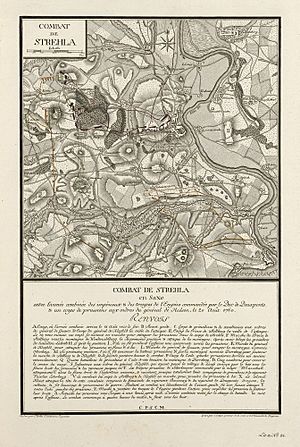Battle of Strehla facts for kids
Quick facts for kids Battle of Strehla |
|||||||
|---|---|---|---|---|---|---|---|
| Part of the Third Silesian War (Seven Years' War) | |||||||
 Battle of Strehla (L. Therbu, G. J. Cöntgen, c. 1760) |
|||||||
|
|||||||
| Belligerents | |||||||
| Commanders and leaders | |||||||
| Johann Dietrich von Hülsen | Frederick Michael, Count Palatine of Zweibrücken | ||||||
| Strength | |||||||
| 12,000 | 25,000 | ||||||
| Casualties and losses | |||||||
| 900 | 1,800 | ||||||
The Battle of Strehla happened on August 20, 1760. It was a fight during the Seven Years' War between the armies of Prussia and Austria. The Austrian army attacked a smaller Prussian group, but the Prussians pushed them back. The battle took place near the town of Strehla in Saxony, Germany.
Contents
Why Did the Battle of Strehla Happen?
Armies Prepare for Conflict
In August 1760, Frederick the Great, the King of Prussia, was getting ready. He wanted to stop Austrian armies from entering Prussian lands. The Austrians planned to attack Prussia from two sides. This is called a pincer movement, like a crab's claws closing in.
Prussia's Plan to Defend Saxony
One Austrian army of 25,000 soldiers moved towards Saxony, a region Prussia controlled. To stop this threat, Frederick sent Lieutenant General Johann Dietrich von Hülsen. Hülsen had 12,000 Prussian soldiers. Their job was to hold the west side of the Elbe River at Strehla.
Austrian Plans Change
Frederick then defeated the other Austrian army in Silesia at the Battle of Liegnitz. This meant the Austrian pincer plan failed. General Hülsen and his army arrived in Strehla. They started to build defenses. The Austrian commander, Frederick Michael, Count Palatine of Zweibrücken, decided not to cross the river at Strehla. Instead, he crossed elsewhere and marched along the river to find Hülsen's forces.
How the Battle of Strehla Unfolded
Prussians Dig In
The Prussian army dug in on high ground around Strehla. They also used a wood west of the town for cover. The Austrians arrived from the south. Zweibrücken split his larger army. He wanted to attack the Prussian lines from different directions. Even though Hülsen knew about this plan, he decided to fight from a strong defensive line.
Artillery Fire and Infantry Clash
The battle started at 5:00 A.M. with cannons firing from both sides. Soon after, some Prussian soldiers broke through the woods. This forced a much larger group of Austrian soldiers to move and face them. At the same time, the main groups of Prussian and Austrian soldiers fought on a field south of the town.
Prussian Counterattack and Victory
After two hours of fighting, the Prussians attacked back. They began to push the Austrians south. Meanwhile, the Prussian cavalry (soldiers on horseback) pushed back the Austrian cavalry on the far right side. Instead of chasing the retreating Austrian cavalry, the Prussian horsemen regrouped. They then charged and defeated several small groups of Austrian soldiers. This success encouraged the Prussian soldiers in the woods. They advanced and pushed back more Austrian soldiers. With both sides of his army being forced back, Zweibrücken ordered his troops to retreat. The fighting ended by 7:00 A.M.
What Happened After the Battle?
Prussians Hold Their Ground
The Prussian army stayed on the battlefield until 1:00 P.M. They waited for another Austrian attack, but it did not happen. Then, Hülsen moved his army from Strehla to Torgau. The Austrian army returned the next day and took over the position the Prussians had left.
Frederick's Thanks and Casualties
Frederick the Great personally thanked Hülsen for holding off the Austrians. The Austrian army lost 1,800 soldiers. This includes those killed, wounded, or captured. The Prussian army lost 900 soldiers who were killed or wounded.

